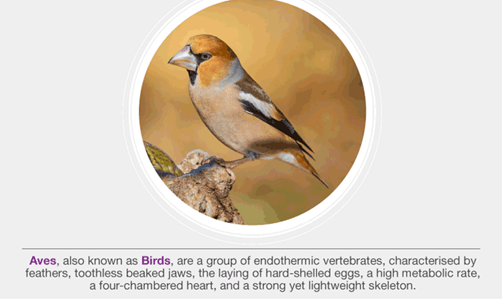Phylum Chordata (Class - Aves & Mammalia) - NEET PDF Download
Aves

The Aves belong to the phylum Chordata of the animal kingdom. It has about 9,000 species. Aves are adapted to fly. All the birds come in the class Aves. They show courtship, parental care, nest building, and territorial behaviour.
Characteristics of Aves
- Birds are warm-blooded animals.
- Their forelimbs are modified into wings.
- They have well-developed flight muscles that help during the flight.
- Their hind limbs are adapted for walking, hopping, perching, grasping, wading and swimming.
- There are epidermal scales on their legs.
- The endoskeleton is bony with long hollow bones filled with air cavities. known as pneumatic bones.
- Their spindle-shaped body minimizes resistance of the wind.
- The feathers help in preventing heat loss and reduce air friction by providing passage to the air.
- There is no skin gland except the oil gland.
- The lower and upper and jaws are modified into a beak.
- They have no teeth.
- They have sharp eyesight.
- The alimentary canal has a crop and a gizzard. The crops help in softening food, and the gizzard helps in crushing the food.
- Pigeons and other seed-eating birds lack a gall bladder.
- They have spongy and elastic lungs for respiration.
- The special vocal organ called syrinx is present at the base of trachea.
- Their heart is four-chambered.
- RBCs are oval, nucleated and biconvex.
- 12 pairs of cranial nerves are present.
- They have a single ovary and oviduct on the left side
- All the birds are oviparous and exhibit sexual dimorphism. The eggs have four embryonic membranes- amnion, chorion, allantois, and yolk sac.
Classification of Aves
The class Aves is divided into two categories:
(i) Archaeornithes
This class of birds are extinct. They had a toothed beak with a long lizard-like tail.
Example, Archaeopteryx
(ii) Neornithes
These include extant as well as extinct birds. They have no teeth and a short tail.
Example, Penguin, Grey Heron, Kingfisher, Duck, etc.
Mammalia
Animals belonging to class Mammalia are referred to as mammals. Mammals are one of the most evolved species in the animal kingdom categorized under vertebrata. They exhibit advanced characteristics which set them apart from all other animals. They are characterized by the presence of mammary glands through which they feed their younger ones.
They are distributed worldwide and have adapted well to their surroundings – from oceans, deserts and polar regions to rainforests and rivers etc. Let us have a detailed look at the characteristics and classifications of the animals belonging to the class Mammalia.
Characteristics of Mammals
Following are a list of distinct characteristics of mammals that separates them from other classes:
- Mammals are warm-blooded animals who give birth to their younger ones.
- They are the most dominant form of animals found in almost all types of habitats.
- They have mammary glands that help them produce milk to feed their younger ones
- Presence of region of the brain known as Neocortex
- Their skin possesses oil glands (sebaceous glands) and sweat glands (sudoriferous glands).
- The fur of hair throughout the body which helps animals adapt to their environment.
- They are heterodont, i.e., possess different types of teeth.
- Mammals also possess cervical vertebrae.
- The skull is dicondylic.
- The trunk is divided into thorax and abdomen.
- The mammals respire through lungs.
- Good sense of hearing as mammals are aided with 3 middle ear bones
- Mammals have a four-chambered heart. The sinus venous and renal portal system are absent.
- Presence of single-boned lower jaws.
- The brain is well developed divided into cerebrum, cerebellum and medulla.
- They possess 12 pairs of cranial nerves.
- Exhibit one of the most advanced forms of Diaphragms.
- The mammals can lay eggs also. They are known as viviparous.
Classification of Mammals
Mammalia has the largest class in the animal kingdom. Based on their reproduction, they are classified into three subclasses:
- Eutheria
- Metatheria
- Prototheria
➤ Eutheria
Mammals under this subclass give birth to young ones. The young ones are developed inside the mother and derive nutrition through the placenta from the mother. Furthermore, it consists of 19 orders, few of which are:
Order | Examples |
Proboscidea | Elephants |
Rodentia | Rats |
Artiodactyla | Cows |
➤ Metatheria
Mammals belonging to this sub-class give birth to immature young ones, hence they stay in their mother’s pouch until they mature. For eg., Marsupials and Kangaroos. They are divided into seven different orders:
Order | Examples |
Notoryctemorphia | Marsupial modes |
Diprotodontia | Kangaroo |
Microbiotheria | Colocolo |
Didelphimorphia | New world opossum |
Dasyuromorphia | Dasyurids |
Peramelemorphia | Bandicoots |
Paucituberculata | South American rat opossum |
➤ Prototheria
Also known as Monotremes, the sub-class Prototheria consists of egg-laying mammals. It has one order having 6 species Order: Monotremata
Example: Duckbilled platypus, Echidna
General Classification of Mammals
The scientists have also classified the mammals on a general basis which makes it easy to learn about the mammals and their distinguishing characteristics.
Classification | Examples |
Animals | Lion, Tiger, Dog |
Marsupials | Kangaroo, Koala, Womba |
Primates | Chimpanzee, Gorilla, Monkey |
Rodents | Squirrel. Mouse, Porcupine |
Cetaceans | Dolphins, Whales |
Other mammals | Seal, Walrus, Sea-lion |
Frequently Asked Questions
What are the major characteristics of mammalia?
These are warm-blooded, hairy living organisms with mammary glands to feed their young ones.
Why is dolphin a mammal?
Dolphin is a mammal because it breathes through lungs and has mammary glands. Moreover, it does not lay eggs and gives birth to its young ones.
How are the mammals classified?
Mammals are classified as eutheria, prototheria, metatheria.
Give examples of prototherians.
Prototherians include platypus and echidna.














